
NEWS
Ceramic coatings, which offer the excellent properties of ceramics such as high hardness and wear resistance, electrical insulation, low thermal conductivity and reproducible surface structures, are used for surface protection.
Thick film and thin film techniques are differentiated in the manufacture of ceramic coatings.
Thick films (> 20 µm) are applied, for example, by thermal spraying. Plasma spraying has shown excellent results in this application. During plasma spraying, oxide ceramic powder or powder mixtures such as aluminium oxide, aluminium oxide / titanium dioxide, zirconium oxide and chromium oxide are melted in a plasma flame at approx. 10,000 °C and sprayed on a previously sandblasted metal surface.
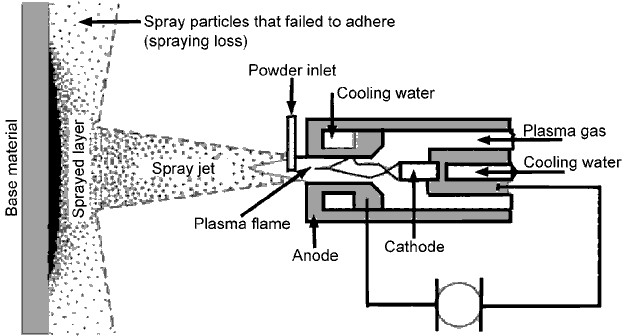
Figure 73: The principle of plasma spraying
However, it is necessaryto ensure that before plasma spraying a fissured surface is created through sandblasting to which the ceramic particles can cling as they arrive.
Several layers are applied, so that a lamellar layer structure with good adhesion results.
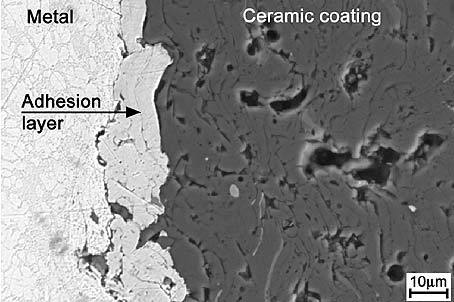
Figure 74: Section through a coating showing the intermediate layer
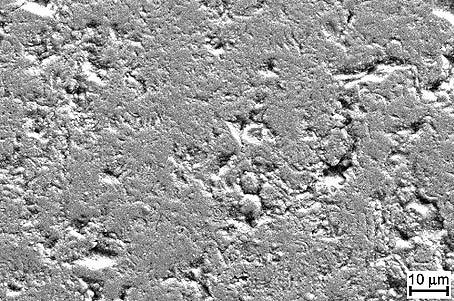
Figure 75: Ground surface of a chromium oxide coating
An advantage of this process is that any metallic material (with the exception of magnesium) can be coated with ceramics. Oxide ceramic powders such as pure white aluminium oxide may be applied for electrical insulation and as a protection against wear, or zirconium oxide for thermal insulation. For increased wear resistance, mixtures of aluminium oxide and titanium dioxide in various proportions are used. Titanium dioxide stabilises the alpha phase of aluminium oxide and makes this ceramic coating tough, and resistant to impact and fracture. Its colour varies between grey, blue grey and black, depending on the mixture. Chromium oxide is preferred over metallic materials for bearings and pumps because of its very good tribological properties. An intermediate layer of nickel-chromium (the ‘bond coat’) improves adhesion.
The ceramic surface is brought to a reproducible roughness through subsequent machining. In most applications, a standard surface with an Ra = 1.5 to 2 µm has been found to be reliable. A shiny surface with a Ra ![]() 0.5 µm is achieved through hard machining.
0.5 µm is achieved through hard machining.
For aluminium oxide, the hardness of the ceramic layers is around HV ![]() 1,800. In comparison, the hardness of hardened steel is around HV
1,800. In comparison, the hardness of hardened steel is around HV ![]() 700, and that of hard-chromed surfaces around HV
700, and that of hard-chromed surfaces around HV ![]() 1,200.
1,200.
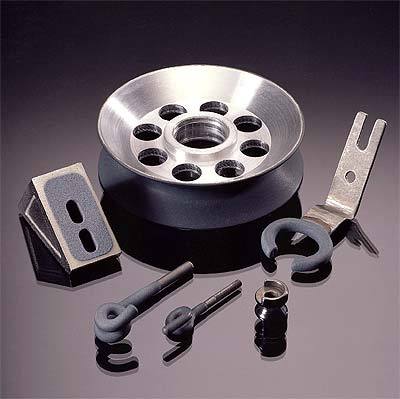
Figure 76: Components coated for wear resistance
The advantage of an insulation layer 0.1 to 0.5 mm thick is the saving of space. It is, moreover, insensitive to heat, shock, and, to a certain degree, to aggressive media and wear. Due to the porous lamellar structure, stainless steel is recommended as the substrate in corrosive environments. An important application of ceramic coatings is their electrical insulation (up to approximately 500 V) at operating temperatures over 200° C, for example of heating elements. The ceramic layer adheres reliably up to 600 °C.
The metal parts should be free from visible blow-holes, scratches and pores, since the growth of the ceramic layer reproduces any surface irregularities. A finely turned or polished metal surface with Rz = 8 to 16 µm is recommended. The thickness of the metal parts should be a minimum of 1 mm in order to avoid heat build-up, which can deform the parts. Thin sheets or wires cannot therefore be plasma sprayed. The maximum length of the metal parts to be coated is dependent on the size of the chamber and extract ducting available, and is typically limited to 2 m.
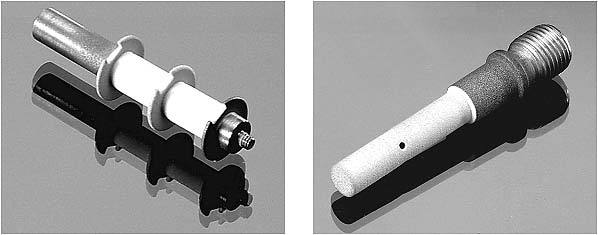
Figures 77 and 78: Components with coatings for electrical and thermal insulation
Adhesion to edges is limited. For this reason, edges should be rounded to have a radius > 0.7 mm. Consideration of the clamping region (thread or pin) is necessary if a design appropriate for coating is to be achieved. Products can also be partially coated. In this case, the metallic surfaces are covered where necessary.
These coating procedures using ceramics are suitable for experimental batches of 1 to 10 as well as for production series of 10,000 or more.
The procedure offers a facility for rapid production at short notice. It allows metal parts to be created on CNC machines, coated and further processed within a few days.
Repair coatings are also of interest. Used ceramic coatings that have been damaged by shocks and impacts during heavy use can simply be sandblasted away. Expensive metal parts can be re-ground and coated with ceramic again.
Plasma sprayed coatings have proved themselves, for example, in textile and wire drawing machines.
Thin films (< 20 µm) are applied by PVD (physical vapour deposition) or CVD (chemical vapour deposition), by galvanic processes or by sol-gel processes. Here, for example, tools with the familiar gold coloured TiN coatings have found wide acceptance.
セラミックコーティングは、高硬度と耐摩耗性、電気絶縁性、低熱伝導性、再現可能な表面構造といったセラミックスの優れた特性を活かして、表面保護に使用されています。
セラミックコーティングの製造では、厚膜と薄膜の技術が区別されています。
厚膜(> 20 µm)は、例えばプラズマスプレーによって適用されます。プラズマスプレーはこの応用において優れた結果を示しています。プラズマスプレーでは、酸化物セラミック粉末やアルミニウム酸化物、アルミニウム酸化物/二酸化チタン、ジルコニウム酸化物、クロム酸化物などの粉末混合物が、約10,000 °Cのプラズマフレームで溶融され、事前に砂噴を行った金属表面にスプレーされます。
ただし、プラズマスプレーの前には、セラミック粒子が着附できるように、砂噴によって表面に割れた表面を作成する必要があります。良好な接着性を持つ層状構造が形成されるように、複数の層が適用されます。
このプロセスの利点の一つは、マグネシウムを除くあらゆる金属材料にセラミックをコーティングできることです。電気絶縁用には純白のアルミニウム酸化物が使用され、耐摩耗性や熱絶縁用にはジルコニウム酸化物が使用されます。耐摩耗性を向上させるためには、アルミニウム酸化物と二酸化チタンの混合物がさまざまな比率で使用されます。二酸化チタンはアルファ相のアルミニウム酸化物を安定化し、このセラミックコーティングを強靭で衝撃や破壊に耐えるものにします。その混合比に応じて、色は灰色、青灰色、黒色などが変化します。クロム酸化物はその非常に優れた摩擦特性から、ベアリングやポンプなどの金属材料に選ばれます。ニッケルクロムの中間層('ボンドコート')は接着性を向上させます。
セラミック表面は後処理によって再現可能な粗さになります。ほとんどの応用では、Ra = 1.5から2 µmの標準表面が信頼性があるとされています。硬削り加工によってRa = 0.5 µmの光沢面が達成されます。
アルミニウム酸化物の場合、セラミック層の硬度は約HV 1,800です。対比すると、硬鋼の硬度は約HV 700、硬クロム表面の硬度は約HV 1,200です。
断熱層の厚さが0.1から0.5 mmであることの利点は、スペースの節約です。また、耐熱性、衝撃耐性、一定程度の侵食性および耐摩耗性にも耐えます。多孔質の層状構造のため、腐食環境ではステンレス鋼が基材として推奨されます。セラミックコーティングの重要な応用の一つは、加熱素子などの運転温度が200°C以上での電気絶縁(約500 Vまで)です。セラミック層は600°Cまで信頼性を持って接着します。
金属部品は、見えるブローホール、傷、孔がない必要があります。セラミック層の成長は表面の不規則性を再現します。表面粗さRz = 8から16 µmの精密旋盤または研磨された金属表面が推奨されます。金属部品の厚さは熱蓄積を避けるために最低でも1 mmである必要があります。そのため、薄板やワイヤーはプラズマスプレーできません。コーティング対象の金属部品の最大長さは、チャンバーサイズや排気ダクトの使用可能な大きさに依存し、通常は2 mに制限されます。
エッジへの密着性は限られています。このため、エッジは半径> 0.7 mmの丸め形状にする必要があります。コーティングが適切なデザインになるように、クランピング領域(スレッドまたはピン)の考慮が必要です。製品は部分的にコーティングすることもできます。その場合、必要に応じて金属表面が覆われます。
これらのセラミックを使用したコーティング手法は、1から10の実験バッチおよび10,000個以上の生産シリーズに適しています。この手法は短期間で迅速な生産を可能にし、CNC機械で金属部品を作成し、コーティングして数日以内にさらに加工することができます。
修復コーティングも興味深いものです。重い使用中に衝撃や衝突によって損傷した使用済みのセラミックコーティングは、砂噴によって簡単に除去することができます。高価な金属部品を再び研磨し、再びセラミックでコーティングすることができます。プラズマスプレーされたコーティングは、例えばテキスタイルやワイヤードローイング機械でその価値を証明しています。
薄膜(< 20 µm)はPVD(物理蒸着)、CVD(化学蒸着)、電気めっきプロセス、またはソルゲルプロセスによって適用されます。例えば、金色のTiNコーティングを施した工具などが広く受け入れられています。